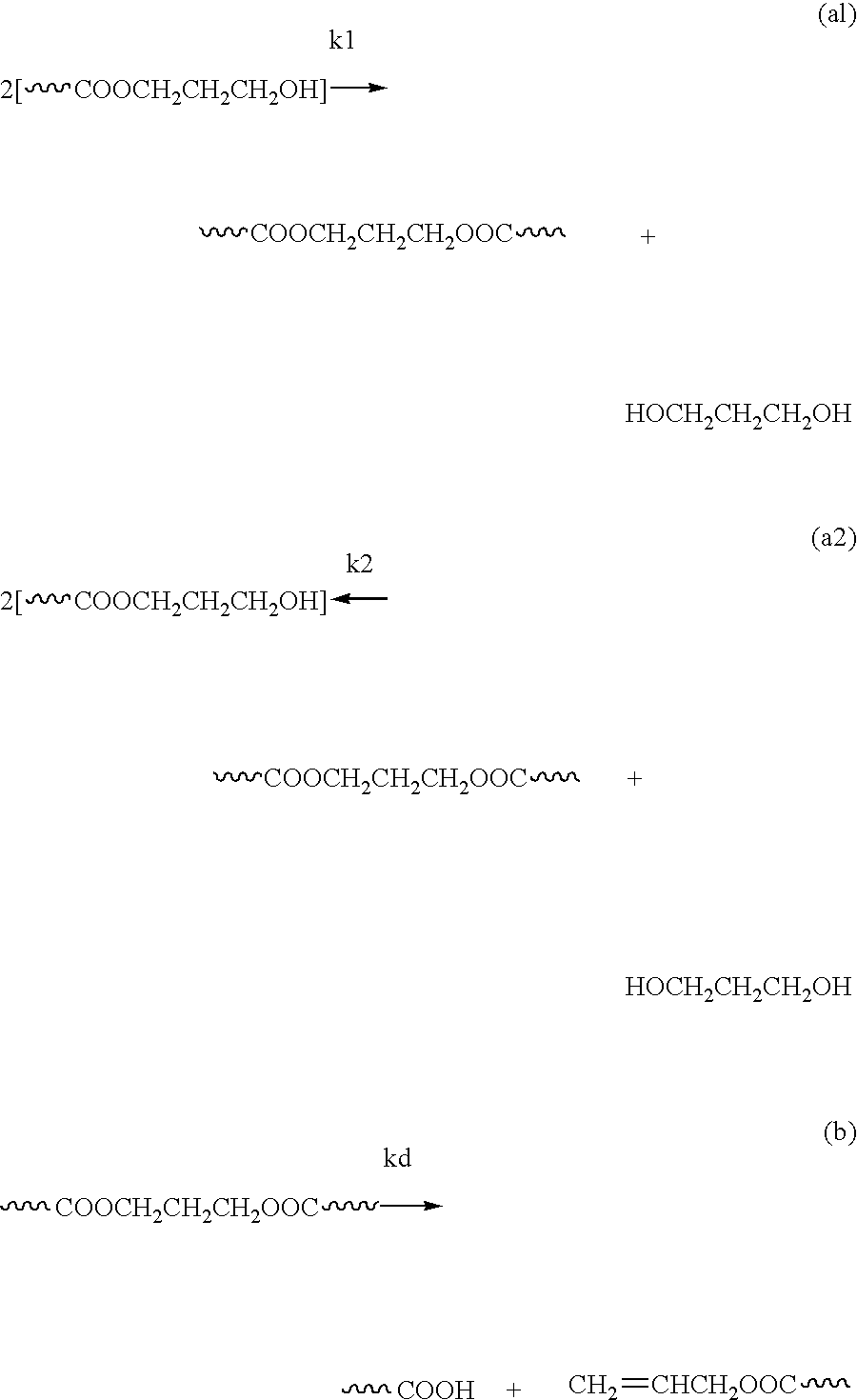Polytrimethylene terephthalate composition particles and process for producing same
a technology of trimethylene terephthalate and composition particles, which is applied in the direction of natural mineral layered products, transportation and packaging, yarn, etc., can solve the problems of insufficient knowledge of the technology, the inability to adequately increase the molecular weight of a ptt by melt polymerization alone, and the inability to meet the requirements of known technologies. , to achieve the effect of efficient dispersibility of pdo, high molecular weight, and efficient dispersibl
- Summary
- Abstract
- Description
- Claims
- Application Information
AI Technical Summary
Benefits of technology
Problems solved by technology
Method used
Image
Examples
example 1 to 3
[0151]Dimethyl terephthalate in an amount of 1,300 g (6.7 moles), 1,144 g (15 moles) of PDO and 0.78 g of titanium butoxide were charged into a 3-liter autoclave equipped with plate-like blades. A transesterification reaction was carried out at 220° C. while methanol was being distilled off. The transesterification reaction ratio was 95%. After finishing the transesterification reaction, 0.52 g of titanium tetrabutoxide as a catalyst and 0.65 g of trimethyl phosphate as a thermal stabilizer were added to the reaction mixture, and the contents were stirred for 30 minutes. A polycondensation reaction was carried out for 2 hours at 260° C. at a vacuum degree of 20 Pa while PDO was being distilled off. After the reaction, the polymer thus obtained was extruded in a rope-like form from the bottom portion of the polycondensation reaction reactor. The rope-like polymer was cut to give pellets having an intrinsic viscosity of 0.5 dl / g and a weight of 25 mg / pellet.
[0152]The pellets thus obta...
example 4 and 5
[0157]The procedure of Example 1 was repeated except that the solid-state polymerization was carried out under conditions explained below.
[0158]The PTT composition particle prepolymer was crystallized under the following conditions: the prepolymer was heated at 210° C. for 15 minutes by the outer wall of an apparatus while nitrogen gas heated at 207° C. was being allowed to flow at a flow rate (superficial velocity) of 100 cm / min in terms of a standard state; the crystallized PTT composition particle prepolymer was charged into a solid-state polymerization apparatus, and heated at 205° C. by the outer wall while a nitrogen gas heated at 205° C. was being allowed to flow at a flow rate (superficial velocity) of 100 cm / min in terms of a standard state to effect solid-state polymerization and give PTT composition particles. Table 1 shows a solid-state polymerization time.
[0159]The PTT composition particles thus obtained were excellent in whiteness and oxidation resistance stability, an...
example 6 and 7
[0163]Dimethyl terephthalate in an amount of 1,300 g (6.7 moles), 1,144 g (15 moles) of PDO and 0.78 g of titanium butoxide were charged into a 3-liter autoclave equipped with plate-like blades. A transesterification reaction was carried out at 220° C. while methanol was being distilled off. The transesterification reaction ratio was 95%. After finishing the transesterification reaction, the reaction products thus obtained were atomized by applying a nitrogen gas pressure of 0.5 MPa, and sprayed to give particles. The particles thus obtained had a particle size of 0.3 mm, a particle weight of 0.3 mg / particle, a terminal carboxyl group content of 30 meq / kg, and a cyclic dimer content of 2.7% by weight.
[0164]The particles thus obtained were heated from 70° C. to 200° C. in one hour at a vacuum degree of 5 Pa to be crystallized. The molecular weight increased during heating. The particles were then subjected to solid-state polymerization at 205° C. at a vacuum degree of 5 Pa to give PT...
PUM
| Property | Measurement | Unit |
|---|---|---|
| particle weight | aaaaa | aaaaa |
| particle size | aaaaa | aaaaa |
| temperature | aaaaa | aaaaa |
Abstract
Description
Claims
Application Information
 Login to View More
Login to View More - R&D
- Intellectual Property
- Life Sciences
- Materials
- Tech Scout
- Unparalleled Data Quality
- Higher Quality Content
- 60% Fewer Hallucinations
Browse by: Latest US Patents, China's latest patents, Technical Efficacy Thesaurus, Application Domain, Technology Topic, Popular Technical Reports.
© 2025 PatSnap. All rights reserved.Legal|Privacy policy|Modern Slavery Act Transparency Statement|Sitemap|About US| Contact US: help@patsnap.com


